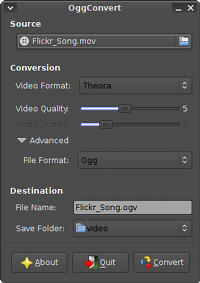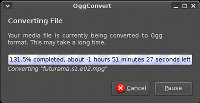Author: Nathan Willis
OggConvert is a simple, GUI-based video transcoder that outputs only to the free Theora and Dirac formats. It couldn’t be any easier to use, and it’s the quickest way to get a feel for the still-new Dirac codec. No need to tweak pages of arcane settings — just drag, drop, and watch.
You can download OggConvert as source code, or as a prepackaged binary for Debian, Fedora, SUSE, or Ubuntu. The latest release is version 0.3. OggConvert is written in Python, and uses GStreamer to perform its media conversion work.
In order to convert to the Dirac format, you need at least GStreamer 0.10.11 and the libschrodinger encoding library. GStreamer should be available on every modern Linux distro; libschrodinger is less mature, so packages are not as widespread, but it’s available through the standard package management systems of Debian, Ubuntu, and Fedora.
Conversion experience
When you launch OggConvert, you could be excused for thinking “that’s it?” The interface is extremely simple. A file selection button is at the top, a couple of option selectors are below it, and a place to specify the output file name and location is at the bottom.
The file selection button opens a GTK file select window that looks for compatible input files. Compatible files include all formats with a MIME type of video/* or audio/* — which does not include existing .ogg media, which are typed application/ogg. Once your input file is selected, you have your choice of Theora or Dirac for the video codec. Two sliders allow you to separately set Video Quality and Audio Quality on a one-to-ten scale.
Under Advanced, you can choose between Ogg and Matroska for the media container format. Matroska support is new in version 0.3; like Ogg, the Matroska format is patent-unencumbered and open source, and is supported by GStreamer. Matroska’s creators assert its superiority over Ogg in a number of areas; the one distinction no one argues about is that Matroska is designed to encapsulate any codec, while Ogg is designed specifically for Xiph.org codecs like Theora.
With the settings to your liking, all you need do is click the Convert button. OggConvert will pop up a progress window, counting the percentage of the job done and estimating the time left until completion. Both factors require some interpretation; in all of my tests, the job was not completed until the progress meter reached well over 130 percent. Running on a single-core 2.4GHz Athlon CPU, I acheived approximately 2x encoding speed using Theora, and just under 1x using Dirac.
I hope to see other minor issues fixed in future releases. For instance, I got several warning messages alerting me that conversion had “stalled” and I should cancel the process, even though conversion continued to churn (as evidenced in the progress meter, console messages, and system monitor)and the final result was a good file.
On the whole, though, OggConvert achieves point-and-grunt simplicity while producing high-quality output. Thanks to GStreamer, all meta-data from the source file is automatically preserved and reproduced in the destination file.
If you have ever used a Swiss Army transcoder like DVD::Rip, you know how many options there really are to codecs like Theora. OggConvert hides them from view, and for a casual user it is the correct move.
I must admit, the first time I used OggConvert, I wanted the one-to-ten quality sliders to present some detailed explanations of each level. But ultimately, “quality” is entirely a subjective measurement; what matters is whether you are satisfied with the look of the video and the size the file occupies on your hard drive. If you feel like experimenting, you can systematically encode the first few seconds of your video at each quality level, cancel the job, then compare the results.
Dirac: delta, equation … codec
Aside from its practical value converting video files to a free format, OggConvert is also noteworthy for letting regular users (i.e., not video codec programmers) experiment with the free Dirac codec.
Dirac was created at the BBC, uses wavelet compression, and is still technically undergoing revision — meaning that the format itself is still changing, not just the libschrodinger software that OggConvert uses to write to it. When you start a Dirac conversion, OggConvert warns you of the codec’s experimental status.
You are likely to see a visible difference between Theora and Dirac, both on screen and on disc. Since libschrodinger is a GStreamer project, you will need a GStreamer-based video player to watch Dirac-encoded files. Theora video is supported by GStreamer too, but also by several non-GStreamer players such as VLC and MPlayer.
OggConvert’s creator Tristan Brindle is excited to see a Dirac encoder nearing the point of real usability. Theora, he says, “is nowhere near as good as Xvid, let alone modern codecs like H.264 and VC-1. The one and only thing it’s got going for it is that it’s free (as in speech), but the majority of people simply don’t care about that.
“With Dirac though, we have (or will soon have) a free video codec that is completely state-of-the-art. Especially with the BBC’s name attached to it, there’s a really good chance to grab mainstream attention in a way that Theora has never been able to. That’s why I added Dirac support to OggConvert very early on, because I think it’s really important that we push it as much as possible.”
In my tests, given the same source material and the same quality settings, the Dirac-encoded files were always larger in size than Theora-encoded versions, took longer to convert, and had more visual compression artifacts. So for the time being, Theora remains the better choice, and OggConvert’s warnings about Dirac justified. But it is encouraging to use a working implementation of Dirac. As libschrodinger is updated, I plan to revisit the codec and watch the improvement.
Last year I wrote about Thoggen, a simple drag-and-drop video converter to easily transcode DVD video into Theora format. OggConvert has a slightly different focus, but my assessment of it is much the same: it works without making you worry about the job, and which is all that matters. The fact that it helps propagate patent-free video formats is icing on the cake.
Category:
- Graphics & Multimedia




